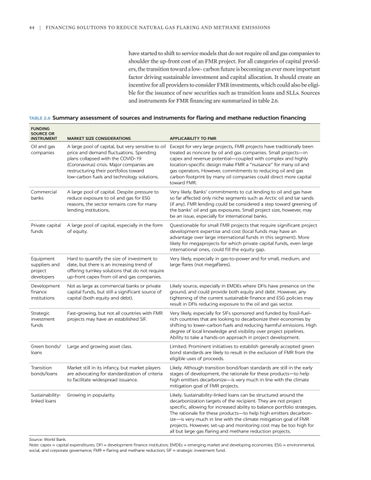44
| Financing Solutions to Reduce Natural Gas Flaring and Methane Emissions
have started to shift to service models that do not require oil and gas companies to shoulder the up-front cost of an FMR project. For all categories of capital providers, the transition toward a low- carbon future is becoming an ever more important factor driving sustainable investment and capital allocation. It should create an incentive for all providers to consider FMR investments, which could also be eligible for the issuance of new securities such as transition loans and SLLs. Sources and instruments for FMR financing are summarized in table 2.6. TABLE 2.6
Summary assessment of sources and instruments for flaring and methane reduction financing
FUNDING SOURCE OR INSTRUMENT
MARKET SIZE CONSIDERATIONS
APPLICABILITY TO FMR
Oil and gas companies
A large pool of capital, but very sensitive to oil price and demand fluctuations. Spending plans collapsed with the COVID-19 (Coronavirus) crisis. Major companies are restructuring their portfolios toward low-carbon fuels and technology solutions.
Except for very large projects, FMR projects have traditionally been treated as noncore by oil and gas companies. Small projects—in capex and revenue potential—coupled with complex and highly location-specific design make FMR a “nuisance” for many oil and gas operators. However, commitments to reducing oil and gas carbon footprint by many oil companies could direct more capital toward FMR.
Commercial banks
A large pool of capital. Despite pressure to reduce exposure to oil and gas for ESG reasons, the sector remains core for many lending institutions.
Very likely. Banks’ commitments to cut lending to oil and gas have so far affected only niche segments such as Arctic oil and tar sands (if any). FMR lending could be considered a step toward greening of the banks’ oil and gas exposures. Small project size, however, may be an issue, especially for international banks.
Private capital funds
A large pool of capital, especially in the form of equity.
Questionable for small FMR projects that require significant project development expertise and cost (local funds may have an advantage over large international funds in this segment). More likely for megaprojects for which private capital funds, even large international ones, could fill the equity gap.
Equipment suppliers and project developers
Hard to quantify the size of investment to date, but there is an increasing trend of offering turnkey solutions that do not require up-front capex from oil and gas companies.
Very likely, especially in gas-to-power and for small, medium, and large flares (not megaflares).
Development finance institutions
Not as large as commercial banks or private capital funds, but still a significant source of capital (both equity and debt).
Likely source, especially in EMDEs where DFIs have presence on the ground, and could provide both equity and debt. However, any tightening of the current sustainable finance and ESG policies may result in DFIs reducing exposure to the oil and gas sector.
Strategic investment funds
Fast-growing, but not all countries with FMR projects may have an established SIF.
Very likely, especially for SIFs sponsored and funded by fossil-fuel– rich countries that are looking to decarbonize their economies by shifting to lower-carbon fuels and reducing harmful emissions. High degree of local knowledge and visibility over project pipelines. Ability to take a hands-on approach in project development.
Green bonds/ loans
Large and growing asset class.
Limited. Prominent initiatives to establish generally accepted green bond standards are likely to result in the exclusion of FMR from the eligible uses of proceeds.
Transition bonds/loans
Market still in its infancy, but market players are advocating for standardization of criteria to facilitate widespread issuance.
Likely. Although transition bond/loan standards are still in the early stages of development, the rationale for these products—to help high emitters decarbonize—is very much in line with the climate mitigation goal of FMR projects.
Sustainabilitylinked loans
Growing in popularity.
Likely. Sustainability-linked loans can be structured around the decarbonization targets of the recipient. They are not project specific, allowing for increased ability to balance portfolio strategies. The rationale for these products—to help high emitters decarbonize—is very much in line with the climate mitigation goal of FMR projects. However, set-up and monitoring cost may be too high for all but large gas flaring and methane reduction projects.
Source: World Bank. Note: capex = capital expenditures; DFI = development finance institution; EMDEs = emerging market and developing economies; ESG = environmental, social, and corporate governance; FMR = flaring and methane reduction; SIF = strategic investment fund.


